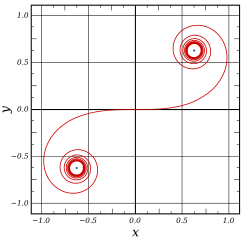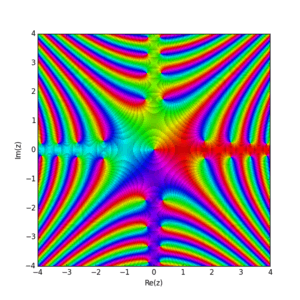Fresnel integral
.svg.png)
Fresnel integrals, S(x) and C(x), are two transcendental functions named after Augustin-Jean Fresnel that are used in optics, which are closely related to the error function (erf). They arise in the description of far field Fresnel diffraction phenomena, and are defined through the following integral representations:

The simultaneous parametric plot of S(x) and C(x) is the Euler spiral (also known as the Cornu spiral or clothoid). Recently, they have been used in the design of highways and other engineering projects.[1]
Definition
The Fresnel integrals admit the following power series expansions that converge for all x:
.svg.png)
Some authors, including Abramowitz and Stegun, (eqs 7.3.1 – 7.3.2) use  for the argument of the integrals defining S(x) and C(x). To get these functions, multiply the above integrals by
for the argument of the integrals defining S(x) and C(x). To get these functions, multiply the above integrals by  and multiply the argument x by
and multiply the argument x by  .
.
Euler spiral

The Euler spiral, also known as Cornu spiral or clothoid, is the curve generated by a parametric plot of S(t) against C(t). The Cornu spiral was created by Marie Alfred Cornu as a nomogram for diffraction computations in science and engineering.
From the definitions of Fresnel integrals, the infinitesimals dx and dy are thus:
Thus the length of the spiral measured from the origin can be expressed as:
That is, the parameter t is the curve length measured from the origin (0,0) and the Euler spiral has infinite length. The vector [cos(t²), sin(t²)] also expresses the unit tangent vector along the spiral, giving θ = t². Since t is the curve length, the curvature,  can be expressed as:
can be expressed as:
And the rate of change of curvature with respect to the curve length is:
An Euler spiral has the property that its curvature at any point is proportional to the distance along the spiral, measured from the origin. This property makes it useful as a transition curve in highway and railway engineering.
If a vehicle follows the spiral at unit speed, the parameter t in the above derivatives also represents the time. That is, a vehicle following the spiral at constant speed will have a constant rate of angular acceleration.
Sections from Euler spirals are commonly incorporated into the shape of roller-coaster loops to make what are known as "clothoid loops".
Properties
- C(x) and S(x) are odd functions of x.
- Asymptotics of the Fresnel integrals as
 are given by the formulas:
are given by the formulas:

- Using the power series expansions above, the Fresnel integrals can be extended to the domain of complex numbers, and they become analytic functions of a complex variable.
- The Fresnel integrals can be expressed using the error function as follows:[2]

![S(z)=\sqrt{\frac{\pi}{2}} \frac{1+i}{4} \left[ \operatorname{erf}\left(\frac{1+i}{\sqrt{2}}z\right) -i \operatorname{erf}\left(\frac{1-i}{\sqrt{2}}z\right) \right],](../I/m/d5bf0cd199a44a331ae322c42e93f0dc.png)
![C(z)=\sqrt{\frac{\pi}{2}}\frac{1-i}{4} \left[ \operatorname{erf}\left(\frac{1+i}{\sqrt{2}}z\right) + i \operatorname{erf}\left(\frac{1-i}{\sqrt{2}}z\right) \right].](../I/m/3ef77df591f45e9f3cbb6c38f45cae27.png)
- or

- C and S are entire functions.
- The integrals defining C(x) and S(x) cannot be evaluated in the closed form in terms of elementary functions, except in special cases. The limits of these functions as x goes to infinity are known:
Evaluation

The limits of C and S as the argument tends to infinity can be found by the methods of complex analysis. This uses the contour integral of the function
around the boundary of the sector-shaped region in the complex plane formed by the positive x-axis, the bisector of the first quadrant y = x with x ≥ 0, and a circular arc of radius R centered at the origin.
As R goes to infinity, the integral along the circular arc tends to 0, the integral along the real axis tends to the half Gaussian integral
and after routine transformations, the integral along the bisector of the first quadrant can be related to the limit of the Fresnel integrals.
Generalization
The integral

is a confluent hypergeometric function and also an incomplete Gamma function [3]

which reduces to Fresnel integrals if real or imaginary parts are taken:
 .
.
The leading term in the asymptotic expansion is
 ,
,
and therefore
 .
.
For m=0, the imaginary part of this equation in particular is

with the left-hand side converging for a>1 and the right-hand side being its analytical extension to the whole plane less where lie the poles of  .
.
The Kummer transformation of the confluent hypergeometric function is

with
 .
.
Applications
The Fresnel integrals were originally used in the calculation of the field intensity in an environment related to the bending of light around opaque objects.[4] More recently, they have been used in the design of highways and railways, specifically their curvature transition zones[1] and roller coasters.[4] Another application is for calculating the transitions on a velodrome track to allow rapid entry to the bends and gradual exit.
See also
References
- ↑ 1.0 1.1 Stewart, James (2007). Essential Calculus. Belmont, Calif.: Thomson Brooks/Cole. p. 230. ISBN 0-495-01442-7.
- ↑ functions.wolfram.com, Fresnel integral S: Representations through equivalent functions and Fresnel integral C: Representations through equivalent functions. Note: Wolfram uses the Abramowitz & Stegun convention, which differs from the one in this article by factors of

- ↑ Mathar, R. J. (2012). "Series Expansion of Generalized Fresnel Integrals". arXiv:1211.3963.
- ↑ 4.0 4.1 Beatty, Thomas. "How to evaluate Fresnel Integrals" (PDF). FGCU MATH - SUMMER 2013. Retrieved 27 July 2013.
- van Wijngaarden, A.; Scheen, W. L. (1949). Table of Fresnel Integrals. Verhandl. Konink. Ned. Akad. Wetenschapen 19 (4).
- Boersma, J. (1960). "Computation of Fresnel Integrals". Math. Comp. 14: 380–380. doi:10.1090/S0025-5718-1960-0121973-3. MR 0121973.
- Abramowitz, Milton; Stegun, Irene A., eds. (1965), "Chapter 7", Handbook of Mathematical Functions with Formulas, Graphs, and Mathematical Tables, New York: Dover, p. 297, ISBN 978-0486612720, MR 0167642.
- Bulirsch, Roland (1967). "Numerical calculation of the sine, cosine and Fresnel integrals". Numer. Math. 9 (5): 380–385. doi:10.1007/BF02162153.
- Hangelbroek, R. J. (1967). "Numerical approximation of Fresnel integrals by means of Chebyshev polynomials". J. Eng. Math. 1 (1): 37–50. Bibcode:1967JEnMa...1...37H. doi:10.1007/BF01793638.
- Press, WH; Teukolsky, SA; Vetterling, WT; Flannery, BP (2007), "Section 6.8.1. Fresnel Integrals", Numerical Recipes: The Art of Scientific Computing (3rd ed.), New York: Cambridge University Press, ISBN 978-0-521-88068-8
- Nave, R. (2002). "The Cornu spiral". (Uses πt²/2 instead of t².)
- Temme, N. M. (2010), "Error Functions, Dawson’s and Fresnel Integrals", in Olver, Frank W. J.; Lozier, Daniel M.; Boisvert, Ronald F.; Clark, Charles W., NIST Handbook of Mathematical Functions, Cambridge University Press, ISBN 978-0521192255, MR 2723248
- Alazah, Mohammad (2012). "Computing fresnel integrals via modified trapezium rules". arXiv:1209.3451.
- Mathar, R. J. (2012). "Series Expansion of Generalized Fresnel Integrals". arXiv:1211.3963.
External links
- Faddeeva Package, free/open-source C++/C code to compute complex error functions (from which the Fresnel integrals can be obtained), with wrappers for Matlab, Python, and other languages.
- Hazewinkel, Michiel, ed. (2001), "Fresnel integrals", Encyclopedia of Mathematics, Springer, ISBN 978-1-55608-010-4
- "Roller Coaster Loop Shapes". Retrieved 2008-08-13.
- Weisstein, Eric W., "Fresnel Integrals", MathWorld.
- Weisstein, Eric W., "Cornu Spiral", MathWorld.







![S(x)=\sqrt{\frac{\pi}{2}} \left( \frac{\mbox{sign}{(x)}}{2} - \left[1+O(x^{-4}) \right] \left( \frac{\cos{(x^{2})}}{x \sqrt{2 \pi}} + \frac{\sin{(x^{2})}}{ x^{3} \sqrt{8 \pi}} \right) \right),](../I/m/9d3184dc93d6af51f61b09e7261c87b5.png)
![C(x)=\sqrt{\frac{\pi}{2}} \left( \frac{\mbox{sign}{(x)}}{2} + \left[1+O(x^{-4}) \right] \left( \frac{\sin{(x^{2})}}{x \sqrt{2 \pi}} - \frac{\cos{(x^{2})}}{ x^{3} \sqrt{8 \pi}} \right) \right).](../I/m/acda46ef5f7682c6387a2f974dc1316e.png)


